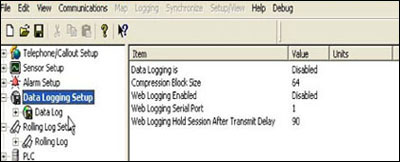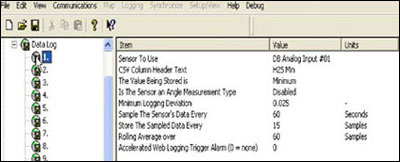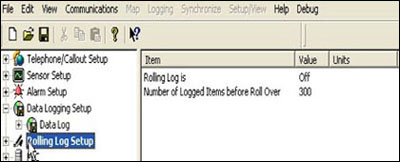Data logging is the practice of chronologically recording sequential data and storing and/or transmitting it for further analysis. These records can then be displayed in tables, graphs and charts to show event changes. The ability to identify trends allows the client to make adjustments in the process to maximize profits and reduce downtime.
Inputs
The XTA can monitor and store 100 linear and 15 rolling log items which can include the 12 Analog, 16 binary, 5 outputs, 1 RTD and one frequency sensor equipped on the XTA as well as registers monitored in ModBus, DGH and DF1 machine protocols.
Types of data logging
The 100 linear log items can be user set to accommodate signal sampling rates, storage rates, angle measurements, averaging, minimum, maximum and deviation. The linear log data is stored in non-volatile memory and are unaffected by a unit power down.
The rolling log items are stored in volatile memory and overwrite when the log if full. Rolling logs are useful for temporarily storing signals that the client needs to check after a major event occurs.
Log Retrieval
The user has three methods to retrieve the XTA log data using the XtelALink program.
1. Physically connect a computer to the XTA serial port,
2. Call the XTA via the telephone system,
3. Have the XTA transmit the data to a corporate web site or an Xtel hosted website.
Web Logging
The XTA uses Internet transport protocols and the data can be sent to a website or a corporate intranet for viewing. Password protected access allows for viewing of data by various levels in the clients organization. This allows field staff to view the data pertaining to their particular part of the operation and allows management to view the data for the entire organization. The website allows the user to reset the logs, download .CSV files for manipulation in a client’s application program, along with the ability to manually control the outputs. The website can be hosted by Xtel or the client can host their own.
Logging Alarm
Prior to a linear log becoming full, the XTA will notify the on call operator via its standard alarm call out procedure. The XTA can also be set to upload its logged data at custom intervals and will increase the uploading frequency when under an alarm condition via the “Accelerated Web Logging Trigger Alarm” feature
Data Logging Inputs on the XTA
XTA
|
XTA Plus
|
|
8 binary inputs
|
16 binary inputs
|
|
3-10 bit analog inputs
|
3-10bit, 8-12bit analog inputs
|
|
Web retrieval
|
Web retrieval
|
|
Dialup retrieval
|
Dialup retrieval
|
|
Local retrieval
|
Local retrieval
|
|
RS232
|
2-RS232, RS485
|
|
2 NO/NC outputs
|
4 NO/NC Outputs
|
|
1 PTT
|
1 PTT
|
|
|
1 Resistive Thermal Device
|
|
|
1 Frequency Device
|
|
|
Modbus
|
|
|
DGH
|
|
|
DF1
|
The following screen shots show the variables available when setting up data logging on the XTA. Some of the items, like “Sensor to use”, are in the drop-down box format and allow the user to scroll through and pick the sensor. Other items, like “CSV Column Header Text”, are blank and allow the user to enter custom text.
Main Logging Set Up Parameters

Linear Log Set Up Parameters

Rolling Log Set Up Parameters

Rolling Log Set Up Parameters.
